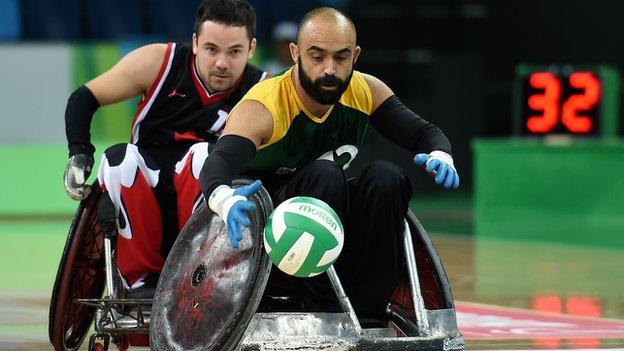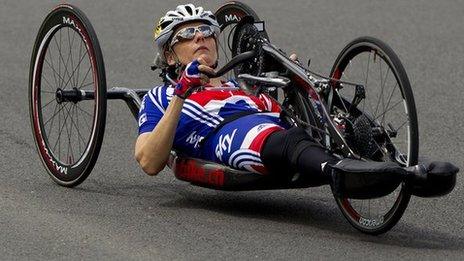Wheelchair rugby at the Rio 2016 Paralympics: All you need to know
- Published
Paralympic Games on the BBC |
|---|
Venue: Rio de Janeiro, Brazil Dates: 7-18 September Time in Rio: BST -4 |
Coverage: Follow on Radio 5 live and via live text commentary |

Wheelchair rugby was invented in Canada in the 1970s by a group of athletes with quadriplegia who were looking for an alternative to wheelchair basketball
How does it work?
Wheelchair rugby is played indoors on a regulation-size basketball court by teams of four, using a white ball that is identical in size and shape to a volleyball. Teams are mixed, with men and women competing equally in the same team.
A match consists of four eight-minute quarters and the team scoring the greatest number of goals wins.
To score an athlete must cross the opposing team's goal line in firm control of the ball. Two wheels must cross the goalline for a score to count.
Athletes must dribble or pass the ball every 10 seconds with failure to do so resulting in the referee handing possession of the ball to the opposing team.
Contact between wheelchairs is permitted and forms an integral part of the game. However, hitting an opponent's chair behind the rear wheel results in penalisation, as does making physical contact with an opponent.
Players may lose possession of the ball, serve a one-minute penalty or be disqualified depending on the extent of the foul committed.
Athletes with tetraplegia or conditions including polio, cerebral palsy, muscular dystrophy and amputations are classified with a points system from 0.5 (highest level of impairment) up to 3.5.
In general, 0.5 and 1.0 players are blockers and do not handle the ball as much as higher class players. This is mostly because of a high level of impairment in their upper limbs that means these players may not easily pick up or pass the ball.
1.5 players are predominantly blockers but may occasionally handle the ball. 2.0 and 2.5 players are both ball handlers and, due to an increasingly high level of strength in their shoulders, can build up speed on court. This makes them good 'playmakers'.
3.0 and 3.5 players have a high degree of strength and stability in the trunk and are therefore usually the fastest players on court. The higher functionality in their upper limbs means they can handle and pass the ball comparatively easily.
In international wheelchair rugby, the total number of points of all four athletes playing on court at any one time cannot exceed 8.0 points unless there is a woman on the court, in which case the team are allowed an extra 0.5.
Who are the British medal hopes?
Great Britain have never won a medal in the sport since it made its Paralympic debut in 2000 and finished fifth at London 2012.
Since then, they finished fifth at the 2014 World Championships and won the European Championships the following year to put them in good stead for Rio.
Who are the other challengers?
USA go into the tournament as the top-ranked team in the world but defending champions Australia will be bidding to retain their title, powered by Ryley Batt, regarded by many as the best player in the world.
Did you know?
The sport was invented in Canada in the 1970s by a group of athletes with quadriplegia who were looking for an alternative to wheelchair basketball.
ParalympicsGB London 2012 medals
None.
- Published23 August 2016

- Published5 September 2016
